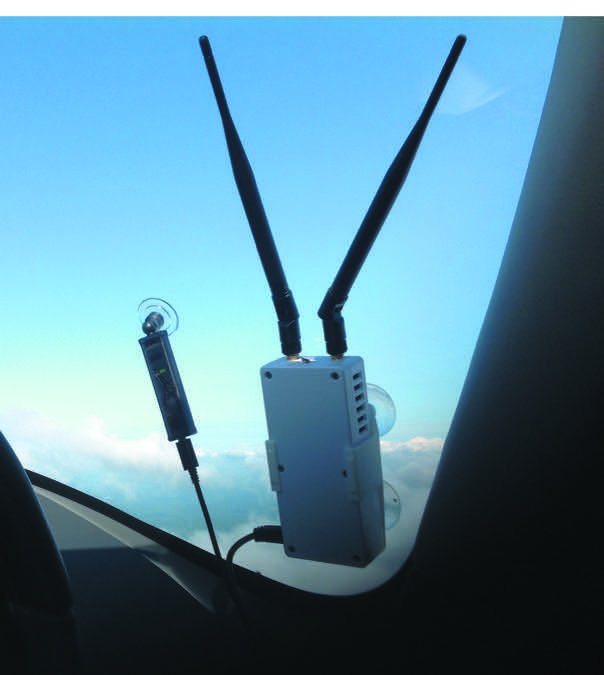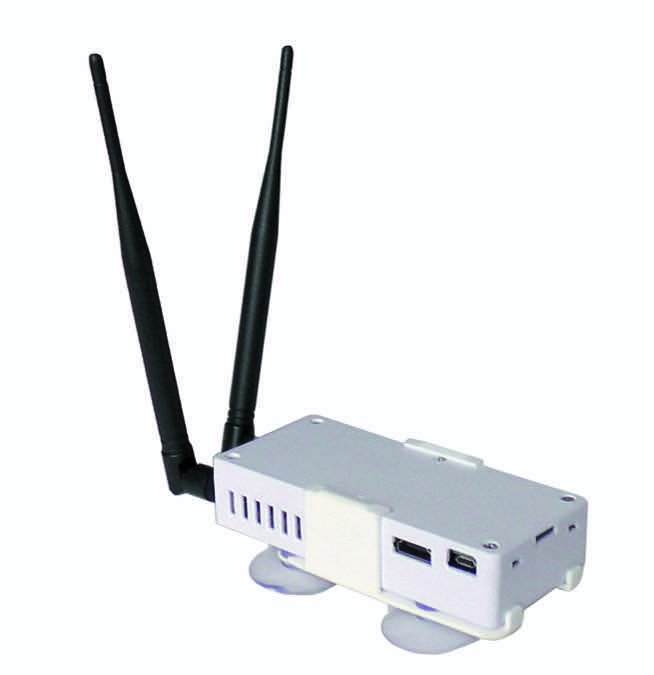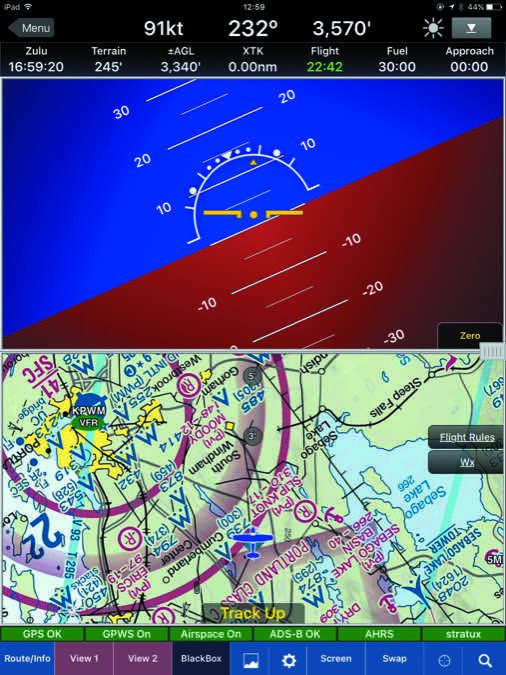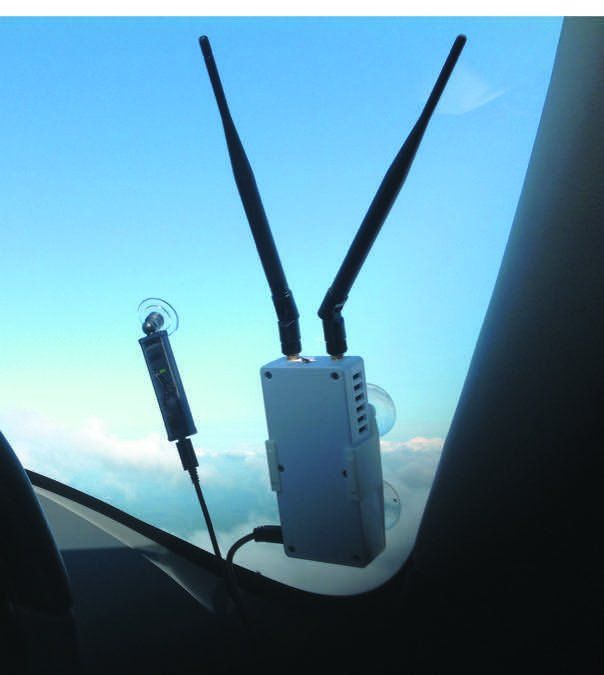Yes, you can get datalink weather in the cockpit for less than $200, plus a tablet device of some kind to play it on.
With the ADS-B mandate creeping closer, we’re seeing more aircraft owners pony up for the minimum compliance of ADS-B Out when transponder work is needed. That satisfies the FAA, but does nothing for receiving weather and traffic information in the cockpit. We flight tested two units that get it done for rock-bottom pricing.
Just The Facts

There are a dozen or more portable ADS-B receiver options out there. Most are several hundred dollars, including the well-known Stratus 2S. This unit only plays its data on ForeFlight, but that’s the app the majority of pilots use. With built-in GPS position, dual-band traffic, AHRS, pressure-altitude sensor (p-alt) and backup battery, the Stratus 2S sets the gold standard, matching or besting every other portable system in our previous evaluations. It’s also $899. Stratus offers the 1S, which offers only the GPS, battery, weather and one traffic antenna. At $549, that’s still not budget, in our view.
Enter the Scout, developed by uAvionix and sold exclusively for use with ForeFlight. It’s a dual-band ADS-B receiver for weather and traffic, and nothing more. No battery, no GPS, no AHRS and (importantly as we’ll see in a moment) no p-alt sensor. Scout is about the size of three sticks of Juicy Fruit gum, and comes with a suction cup and a long USB cable. Hang it up, plug it in, connect via Wi-Fi to your tablet and you’re done. Price: $199.
The only other option for under $200 has been building your own ADS-B In using the open-source Stratux software, created by Chris Young. This system uses off-the-shelf hobbyist equipment to create something that, on paper, has all the features of a Stratus 2S. We built one and reviewed it the February 2016 Aviation Consumer and found it functional, but not equal to a production Stratus 2S in performance. However, it can send data to virtually every aviation app, including ForeFlight.
Young has continued to develop Stratux, and has allowed other companies to sell pre-assembled ones, including iFly, FlightBox and the new Merlin by Seattle Avionics. Young has also launched his own pre-built box with dual-band, high-gain antennas, GPS, AHRS and p-alt. It’s called the RXWX. Price on Amazon: $179.
Ladies and gentlemen, we have a contender.
Head To Head

We flew with the Scout and Young’s prototype RXWX in northern New England where ADS-B tower coverage is marginal, and on a 1700-mile trip to watch a certain two-minute celestial event. That trip was in an airplane with both a Stratus 2S and a Garmin GTX 345 ADS-B transponder for comparison. Ranking the results depends on what matters most to you: performance, convenience or features.
Performance-wise, the RXWX bested the Scout, but not by much. We routinely saw the RXWX picking up one or two more ADS-B towers than the Scout. This ceases to matter once three towers are in range, so the importance depends on where you fly and how high. In the ADS-B Out aircraft, there was zero difference in traffic reception between the units because we were receiving custom traffic from the ground stations. In the non-ADS-B Out aircraft, the RXWX appeared to pick up more 1090 direct traffic, but it was all high-altitude airliner traffic. We feel this is a distinction without a functional difference.
Reception is all about antennas, and uAvionix told us that’s a place Scout is challenged, because of its small size. Stratux units are challenged there because they use tunable receivers that don’t have the fidelity of dedicated ones. For comparison, the Stratus 2S routinely picked up one or two more towers than either Stratux or Scout, and the installed GTX 345 with its external antenna could read even more, and much sooner.
Scout wins hands-down for convenience. It dangles in a window like an air freshener. You must plug it in because it has no battery, but it draws so little power that it’ll run all day on a cellphone backup battery with charge remaining. The same battery can’t even power an RXWX. You’ll want a 10,000 mAh USB battery, or have the RXWX plugged in, for reliable operation.
The next version of RXWX may have an internal battery backup for a couple hours operation, but that unit will retail for more than $200.
During our evaluations, we did quite a bit of app-switching and noticed the RXWX seemed slower in reconnecting to ForeFlight than Scout or Stratus after switching apps or waking the iPad from sleep mode. This delay was a minor inconvenience, and would be a non-issue if you left ForeFlight open throughout the flight.
Scout has automatic firmware updates through ForeFlight. Updating RXWX (or any Stratux-based system) is done via a webpage off your tablet or through an app that offers that feature, like the free version of Aerovie. Point to Scout if you’re a ForeFlight user.
Feature Set Differences

If you’re not using the ForeFlight Mobile app, a Scout is of no use to you. In an earlier version of the product, it wasn’t exactly supposed to be that way as we explain in the sidebar on page 17.
However, there are two good reasons even a ForeFlight user might want the RXWX even though it’s bigger and more power-hungry. One is if your tablet doesn’t have a reliable GPS source. RXWX offers WAAS-GPS that was rock solid in our tests.
The other is p-alt for traffic, particularly if you have ADS-B Out. RXWX (as we’ll as Stratus 2S or installed ADS-B In like the Garmin GTX 345) uses your current pressure altitude as part of the equation to show relative traffic altitudes.
The Scout uses pure GPS altitude. The difference is rarely more than a couple hundred feet—but that makes all the difference when the alert delivered by the Scout says traffic is 200 feet above you and the RXWX shows it at your altitude.
Given how much traffic there was around the eclipse, we had opportunity to see this behavior more than once. This is worth serious consideration if the portable ADS-B In is your only traffic display.
RXWX, and all the Stratux-based systems, have a couple other things going for them. One is clearly the use in apps besides ForeFlight. Young is also developing other interfaces, including a community-sourced ground weather network for Canada. He’s committed to keeping Stratux open-source and available for personal and commercial use.
AHRS Input From RXWX

Under the current Stratux build, RXWX and related systems can’t send AHRS data to ForeFlight. This was specifically disabled by ForeFlight. Officially it was because they didn’t want AHRS information from equipment they couldn’t vouch for appearing in their app for liability reasons.
The policy also gives the Stratus 2S the sole ability to offer backup AHRS in the most popular app out there.
Young has a workaround in development for AHRS to ForeFlight and hopes the growing number of Stratux-based users will convince ForeFlight it’s a net positive in gained safety rather than a liability negative. Only time will tell.
Some Stratux users have reported better results with the Stratux AHRS system compared to the one in the Stratus 2. This has not been our experience in multiple tests. In fact, we’ve found the Stratus 2S AHRS to be the most reliable, easiest to adjust iPad AHRS on the market. We’ve even seen it outperform the backup AHRS in the Garmin GTX 345 transponder.
That said, the AHRS performance from the RXWX was adequate for basic aircraft control using WingX Pro or Aerovie. Head-to-head the Stratus 2S was still a better performer in our tests in coordinated or uncoordinated flight. Extreme changes in attitude tested on the ground (because we didn’t have an aerobatic aircraft handy) will confuse the units about equally.
The biggest factor in AHRS performance seems not to be the sending unit so much as the tablet displaying the AHRS information. It’s demanding graphically, and small delays make huge differences. If this function matters to you our strong recommendation is to invest in the fastest, newest tablet you can, more than any specific AHRS source.
No Excuses
At under $200 you can’t ask for much less in price to put weather and traffic in your cockpit. And while consumer electronics prices keep dropping, there is a bottom end just to make it worth someone’s time to sell. We may be there now. You can’t go wrong with almost any receiver for weather and traffic, but before you scoop up a Scout for its simplicity and size, consider an RXWX or similar unit for more features at the same price.
What Happened With The Pingbuddy 2?
The buzz at Sun ‘n Fun this past spring was the uAvionix pingBuddy 2, a dual-channel ADS-B In receiver that had essentially the identical chassis as the current Scout. Priced at $149.99, Seattle Avionics (maker of the FlyQ app) was one of the major companies pre-selling the device and expected to start fulfilling orders within a month. If you bought one, you know the orders never came to fruition. Seattle was ultimately tasked with refunding its customers—and eating the credit card fees and its pingBuddy 2 advertising investment. Other vendors were to sell the pingBuddy 2, too.
We asked Shane Woodson, the uAvionix sales director, just what happened with the pingBuddy 2. He told us the company pulled the device back into development, reiterating that the product was only offered initially for pre-order, never really made it to the market and was never shipped to customers due to various delays.
“We later collaborated with ForeFlight to help accelerate the product to market, for integration and for the user experience,” Woodson said.
The real story here is that the pingBuddy 2’s replacement—the Scout—is only supported on ForeFlight Mobile and iOS. As we said in the main text, it’s useless if you want to use it with Seattle’s FlyQ and WingX, to name two apps, or on an Android device. Frankly, we don’t see this closed architecture benefiting the market. To be fair, Garmin has faced similar criticism for some of its products, including some ADS-B receivers. According to Seattle Avionics’ Steve Podradchik, the market once benefited from industry standards and good interoperability between devices made by different vendors, but ADS-B has been the exception. Podradchik makes a solid point that ADS-B receivers rebroadcast (over Wi-Fi) traffic and weather data that’s paid for by tax dollars.
“We’ve seen some vendors open its system architecture, but ForeFlight has consistently been on the vanguard of closed systems, presumably because it is worried about a sliding market share,” he told us.
On the other hand, ForeFlight did open its app to Garmin when the company’s later-gen Flight Stream wireless cockpit network hit the market. This enables ForeFlight Mobile users to display Garmin’s ADS-B weather and traffic data, plus send flight plans bidirectionally between the panel and the tablet app. Competitors still, Garmin’s Pilot app has gained sizable market traction. Plus, Garmin’s recently introduced GDL50-series SXM/ADS-B receivers only work with Garmin Pilot app and some of the company’s portable GPS systems and not with ForeFlight.
As we go to press, Seattle Avionics announced its own branded ADS-B receiver called the Merlin. Expected to sell for $250, it’s based on the Stratux core, but for buyers who don’t want to assemble their own, Seattle does and includes a battery, tests the unit and provides a users manual. Unlike the Scout, Seattle says the Merlin will have an open architecture for playing with a variety of third-party apps.


